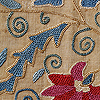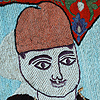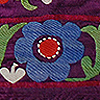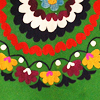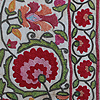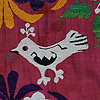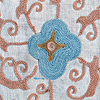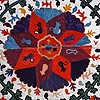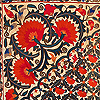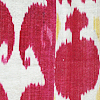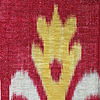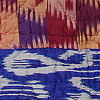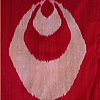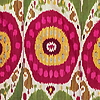 Antique Silk Ikat
Antique Silk Ikat

Making of Silk in Nature
In Iran, during the spring month of Ardibehest (late April), the process of spinning silk thread starts with silkworm breeders buying boxes of eggs of the silk moth, Bombyx mori (Latin for 'silkworm of the mulberry tree'). They place the eggs in a warm place or in an incubator to help speed the hatching of the eggs, a process that takes about ten days. The eggs will hatch into larvae called silkworms.
At the same time, mulberry trees will have grown new leaves which silkworm breeders buy to feed their silkworm larvae. in Iran, mulberry trees grow in Gilan, Mazandaran, Khorasan, Eastern Azarbaijan, Isfahan, Yazd and Kerman. Once the larvae hatch they eat the leaves of the mulberry continuously.
In Yazd, the town of Taft situated some 18 km southwest of Yazd city is a major silkworm breeding centre.
After the larvae (the silkworm) have moulted four times, that is when they are in the fifth instar, they loose their appetite and are ready to transform themselves into moths. To protect themselves while they are in a vulnerable almost motionless transformational pupa state, they enclose themselves in a protective cocoon enclosure. The cocoon is made out of silk thread, a continuous natural protein filament that they produce in their salivary glands and exude to form the filament.
The larvae's cocoon is built up from about 300 to 900 metres (1,000 to 3,000 feet) of silk filament. The filament is fine, lustrous, and about 10 micrometers (1/2,500th of an inch) in diameter. Each cocoon consists of about a kilometre of silk filament, and about 2,000 to 3,000 cocoons are required to make a pound of silk.
For the making of commercial silk thread, the cocoon's filament is unravelled. The filament from several cocoons are then passed over a pulley, wound together and spun into a thread. Two or three threads are in turn spun together to build a yarn and several strands of yarn can be spun further spun together to make a nett thread. Along the way, the yarn or thread is dyed if needed after which it is ready for weaving.
 Ikat History
Ikat History
Ikat is a resist dye technique used to pattern textiles. The more common methods of resist dyeing involve covering parts of a fabric to shield the reserved areas from penetration of the dye, as in tie-dyeing, where threads are wound around the fabric, or in batik, where wax is applied to the surface of the cloth. The term “ikat” by contrast, is used for a process where prior to weaving, warp (lengthwise yarn) or weft (crosswise thread) or sometimes both are tied off with fiber knots that resist absorbing color and are then dyed. To facilitate the pattern tying, the threads are set up on a frame. They are then grouped into bunches of several threads to be tied at once; this results in the creation of knot units from which the overall pattern is built up. Resist ties are removed or new ones added for each color; their combinations create the design. After dyeing is completed, all resists are opened, and the patterned yarns are woven.
The word “ikat” comes from the Malay-Indonesian word for “tie”; it was introduced into European sources of textile technology and history in the early twentieth century when Dutch scholars began paying attention to the rich textile traditions of the Netherlands Indies, the present-day Indonesia. Depending on whether the tied fibers are applied to the warp or weft, the technique is identified as either warp ikat or weft ikat. A third variety, double ikat, combines both warp- and weft-tied resist. For the pattern to be visible, the resist-dyed thread system has to be the prominent one, so for warp ikat, the weave has to be warp-faced, and weft ikat needs a weft-faced structure, which means that either warp or weft is predominantly visible. Plain weave is especially suitable for showing the ikat’s design, but for weft ikat, a twill weave may also be used. Double ikat, where the design is built up from both systems, should ideally by woven in a balanced weave, with warp and weft equally visible. All textile fibers may be used for ikat, although silk and cotton are the most common ones. For the seminal study of ikat as a resist dye technique, its history and geographic distribution, see Alfred Bühler (1972).
History of the Technique
While it is not known when and where the resist technique first developed, Asia has several cultural regions with a particularly strong ikat tradition. Maritime Southeast Asia, India, and Central Asia are all potential candidates for the origin of the technique, but it may also have evolved independently in several locations. Ikat may have spread at an early age through many parts of the Austronesian-speaking world, as technical similarities exist between Indonesian ikat production and that of Madagascar, which was settled by maritime Southeast Asians early in the first millennium B.C. As Malagasy weavers also use a distinctly Austronesian version of a horizontal back-strap loom, the technique may have arrived simultaneously with the spread of loom technology. Ikat patterning is probably represented in garments shown in the Ajanta cave paintings of India (from the fifth to the seventh century). A fragment patterned in the technique, kept for centuries in the Horyuji temple at Nara but now in the Tokyo National Museum, was apparently brought there from China during the Tang period (618-907 A.D.), but was probably produced in Central Asia. Cotton textiles with relatively simple warp ikat stripes were made in Yemen by the eighth or ninth century and were traded to Egypt, where they have survived.
Early ikat production is also testified for pre-Columbian South America, in particular Peru, where a few examples of ikat survive from before the common era. The Mapucha of Chile still produce indigo-dyed warp ikat textiles. Guatemalan ikat, on the other hand, may have been introduced originally as trade textiles brought by the Spanish from the Philippines and could ultimately have a Southeast Asian source. West African weavers also make use of the technique, in particular in Ghana, the Ivory Coast, and Nigeria. In the Mediterranean world and Europe, ikat apparently developed in response to Islamic textiles; it first appeared in Italy in the seventeenth century as an influence from warp-ikat striped mashru cloth (a warp-faced satin weave with silk warp and cotton weft) made in Syria and Turkey. For its spread through Europe, especially France, Majorca, and Spain, see Marie-Louise Nabholz-Kartaschoff.
Nineteenth- and twentieth-century evidence show that at least during the last two hundred years, Asia produced the most varied and highest quality ikat textiles, and a survey of the technique will inevitably have the continent as its main focus, although the occurrence of ikat worldwide needs to be acknowledged. Particularly fine material survives from India, Central Asia, Southeast Asia, and Japan. China, otherwise of course a producer of quality textiles, apparently has not developed the technique to any degree, at least outside its Central Asian provinces.

